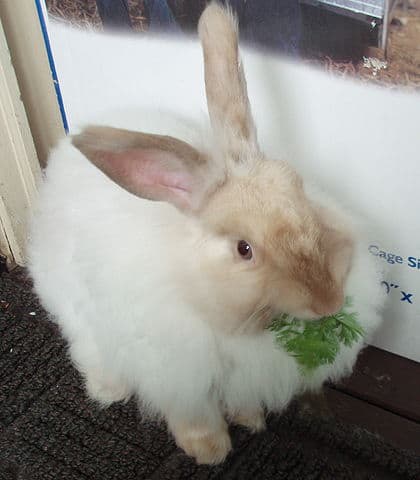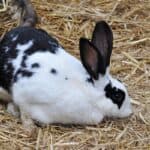
Is an Angora Rabbit the Right pet For You?
As with all rabbits, angora rabbits are inexpensive, and not too expensive to maintain. They have good resistance to disease . Angora rabbits are easy to groom as long as it is done very regularly. Maintaining a clean and neat coat is the most important task when it comes to Angora rabbits. It is essential to keep your fur without knots and clean. Do not adopt an Angora rabbit if brushing your rabbit is a chore. It is worth noting that the German Angora Rabbit requires a little less maintenance.
How to take care and maintain the hair of Angora Rabbit:
Materials required to maintain the hair of angora Rabbit:
- 2 brushes of two different sizes, a small one for the corners and a larger one for the rest of the fur. It should be brush with specific metal bristles for animal grooming.
- 1 comb to untangle any knots
- 1 pair of scissors for recalcitrant knots.
- 1 nail / claw clipper for animals.
How to Brush the Hair of Angora Rabbit
The weekly task consists of a good brushing to untangle the knots and clumps of hair. This task can easily be repeated a second time during the week. Removing the hairs that have come off helps prevent a wool ball. If your objective is to use your rabbit’s wool, I advise you to “blow” it with a grooming fan sold in pet stores, by separating the hairs from each other, this will allow a better production of these. and avoid knots.
Brushing the hair of Angora Rabbit: step by step
The easiest way is to put your Angora rabbit on your lap. Brush the hairs on the upper back and sides first.
Then, gently take your rabbit by the skin of the neck and roll it over onto its back. Hold the skin so that your rabbit lets it go and doesn’t scratch you. If you do it gently, he won’t suffer. You can now brush the stomach, neck (bib) and legs.
The comb will be used for stubborn knots and in case of failure all you have to do is cut the conglomerated hairs, being careful not to injure your rabbit with the tip of the scissors.
Once or twice a week, your Angora rabbit will quickly get used to this brushing.
Moulting :
The majority of Angora rabbits naturally molt 3-4 times a year. Or approximately every 90 days. It’s a normal process. Only the German Angora rabbit escapes the rule somewhat, which is why it will sometimes have to be sheared, especially on the most important parts such as the back, neck (bib) and belly.
As soon as you see mounds of wool hanging from the bars of the cage or that you see your Angora rabbit dragging tufts of wool, it is time to harvest this one.
If you want to save it for spinning or felting, try waiting until the wool measures about 2 inches on a healthy dwarf angora rabbit.
To harvest the wool , you just need to pinch it in your fingers, and pull it out of the fur. Since these are loose hairs, it does not hurt your rabbit, it is the same principle as when a dog sheds. It takes about one to two hours to harvest the wool from a rabbit. This can be spread over two days to lighten this task for the bunny and for you.
The wool can be stored between two sheets of tissue paper, which are stored in a paper bag or cardboard box. Each tuft of wool must be placed parallel to the others and in the same direction.
Why harvest wool of Angora Rabbit?
Besides the use that can be made of it. The harvest is beneficial for the Angora rabbit.
Once the wool comes off its fur, the risk is that it will ingest it, but unlike cats, the Angora rabbit is not able to regurgitate it, so there is a risk of obstruction of the digestive system. or intestinal. Symptoms of this obstruction include complete loss of appetite and the urge to drink. The rabbit can therefore die quickly from dehydration or from hunger. As for the stools, they become less numerous, small and dry. In the extreme, the rabbit also stops urinating. Healthy rabbit feces are large, ball-shaped, and moist. Another symptom is obviously apathy. If you have the slightest doubt that he has ingested a tuft of wool, immediately consult a veterinarian specializing in rodents.
Feeding your Angora rabbit
Another important care is the diet of your Angora rabbit . If you want to maintain your wool production, I advise you to increase your protein intake.
Following food can be given to angora rabbits
Pellets purchased commercially:
15% of their diet can consist of commercial granules rich in protein. Up to 6 months: enough food at your rabbit’s discretion.
After 6 months, the intake should be regulated:
French, German or satin Angora rabbit : between 3/4 and 1 cup of granules per day.
English angora rabbit : between ½ and ¾ of a cup of granules per day.
The hay :
The hay addition to angora rabbits diet limits the wool agglomerates. Little tip: put the hay in a tube so that they can use it as they go, this will prevent the hay from getting lodged in their fur.
The water :
The rabbit must always have fresh water within reach, so that it is not soiled, the best solution is the water bottle outside the cage with a nozzle that goes between the bars.
The sweets :
To reserve at the best time with your rabbit, for example, once a week after cleaning the dwarf rabbit cage . You can give natural treats: banana, apple, broccoli, papaya, etc. Or store-bought treats, be careful in moderation because their fat intake is more important. However, one must be careful with the digestive system of young rabbits which is more sensitive to changes in the diet, start the treats with small amounts around the age of 4.6 months.






